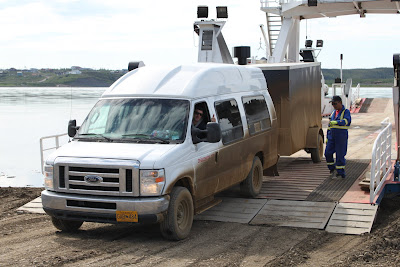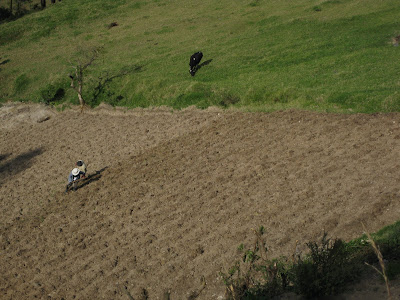 Most people who romanticize about sleeping in tents don't do it very often. Each year I average 150 bag nights, in a tent, somewhere. Leading camping tours from April to November, from the deserts of the Southwest to the Rocky Mountains to Alaska and the Yukon, I've seen a lot of weather. On Key West my tent became a stifling greenhouse and I had to sleep outside on the sand. Overlooking the Mackenzie River in the Northwest Territories, I woke to a survival situation at 3 am as a sudden windstorm threatened to blast our tents off the knoll. Nothing quite like running around in the middle of the night, arctic sun still up, frantically hammering down ropes. In West Glacier, Montana, a September morning revealed soaked tents, sodden, collapsed cook canopies and expressions of grim doubt. Last summer in Seward, Alaska, our campground turned into a frigid, muddy lake overnight. While my passengers were out watching killer whales in the fjords, I was mopping out tents and digging drainage canals.
Most people who romanticize about sleeping in tents don't do it very often. Each year I average 150 bag nights, in a tent, somewhere. Leading camping tours from April to November, from the deserts of the Southwest to the Rocky Mountains to Alaska and the Yukon, I've seen a lot of weather. On Key West my tent became a stifling greenhouse and I had to sleep outside on the sand. Overlooking the Mackenzie River in the Northwest Territories, I woke to a survival situation at 3 am as a sudden windstorm threatened to blast our tents off the knoll. Nothing quite like running around in the middle of the night, arctic sun still up, frantically hammering down ropes. In West Glacier, Montana, a September morning revealed soaked tents, sodden, collapsed cook canopies and expressions of grim doubt. Last summer in Seward, Alaska, our campground turned into a frigid, muddy lake overnight. While my passengers were out watching killer whales in the fjords, I was mopping out tents and digging drainage canals.Last summer in Alaska I saw a lot of rain. It felt wet, but when camping and living out of doors, all weather becomes a richer, more intimate experience. After several days of cold rain and mud, a two-hour break of sun can feel like a two-week Caribbean vacation. By the end of last summer, after three months of leading trips in Alaska, I was saying things like "One clear day is worth three rainy days" and "The only bad weather is weather that keeps us from doing what we want." Which is actually true. And besides - if you're in a kayak, on the water, paddling through brash ice, socked in by cloud, who cares if it's raining?
Water, in various forms, is one of the most dynamic and salient aspects of the Alaskan landscape. Clouds, glaciers, rivers, harbors, bays and sounds, the ocean, rain, fog, snow, ice - they're all on display in The Last Frontier. Never passive, water only caused me real trouble when key roads were washed out in flash floods in the Yukon and eastern Alaska. In one case this was a blessing in disguise, as I had no choice but to reroute a tour from the Yukon to the Alaskan Arctic, seeing some amazing landscapes I wouldn't have otherwise. Here are a few photos and words from up north.
 Resurrection Bay and Seward Harbor
Resurrection Bay and Seward Harbor
From the journal:
6/30/10 Destruction Bay, Yukon
". . .woke up in Tok to the first sun in five days. Everyone was cheerful and stripped down to t-shirts. By 10:30 it was cloudy again. . . as I write this in my tent it's coming down. Everything is wet and dirty. No mountains visible anywhere due to cloud cover. And nothing to do tomorrow but hike or sit. . . it has to break sometime, doesn't it?"
6/14/10 Seward, AK
"Lying in a broken, shitty tent with water coming in. Been raining all day and doesn't look like stopping. Mud and puddles everywhere. Quiet mood. Wet tents. The hike to Harding Icefield tomorrow will be tough if it doesn't let up. . . what else can we do in Seward?"
7/25/10
"Alaska is teaching me to enjoy every nice day."
7/31/10 Fairbanks, AK
". . . drove to Whitehorse anyway. Found out that afternoon that they'd repaired the Dempster Highway washouts and gotten one lane open again. Changed everything again - calling, booking, canceling, booking again, getting on the phone with the DOT. After a beautiful seven-hour drive north to Dawson City, the first thing we saw in town was a sign saying the Dempster had been washed out again. . . the Taylor highway (only other way out of town) had been washed out but was supposed to open Friday morning. . . we made it through to Chicken and then hauled ass to Fairbanks. Later found out someone hit the Lakaina River bridge on the McCarthy Road and it's temporarily closed."
8/28/10 Anchorage
"Last time at Denali on tour. . . woke to rain and didn't feel like getting out of my sleeping bag. Also very hungover. . . Spent the lunch stop crawling around in the water, changing the van tire."
6/30/10 Destruction Bay, Yukon
". . .woke up in Tok to the first sun in five days. Everyone was cheerful and stripped down to t-shirts. By 10:30 it was cloudy again. . . as I write this in my tent it's coming down. Everything is wet and dirty. No mountains visible anywhere due to cloud cover. And nothing to do tomorrow but hike or sit. . . it has to break sometime, doesn't it?"
6/14/10 Seward, AK
"Lying in a broken, shitty tent with water coming in. Been raining all day and doesn't look like stopping. Mud and puddles everywhere. Quiet mood. Wet tents. The hike to Harding Icefield tomorrow will be tough if it doesn't let up. . . what else can we do in Seward?"
7/25/10
"Alaska is teaching me to enjoy every nice day."
7/31/10 Fairbanks, AK
". . . drove to Whitehorse anyway. Found out that afternoon that they'd repaired the Dempster Highway washouts and gotten one lane open again. Changed everything again - calling, booking, canceling, booking again, getting on the phone with the DOT. After a beautiful seven-hour drive north to Dawson City, the first thing we saw in town was a sign saying the Dempster had been washed out again. . . the Taylor highway (only other way out of town) had been washed out but was supposed to open Friday morning. . . we made it through to Chicken and then hauled ass to Fairbanks. Later found out someone hit the Lakaina River bridge on the McCarthy Road and it's temporarily closed."
8/28/10 Anchorage
"Last time at Denali on tour. . . woke to rain and didn't feel like getting out of my sleeping bag. Also very hungover. . . Spent the lunch stop crawling around in the water, changing the van tire."





















































